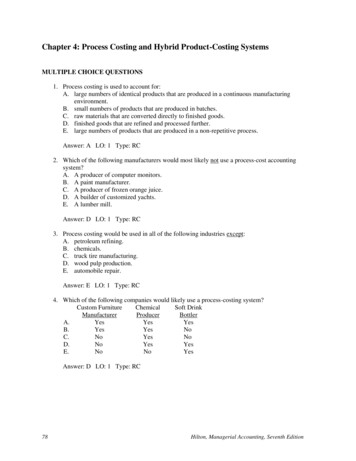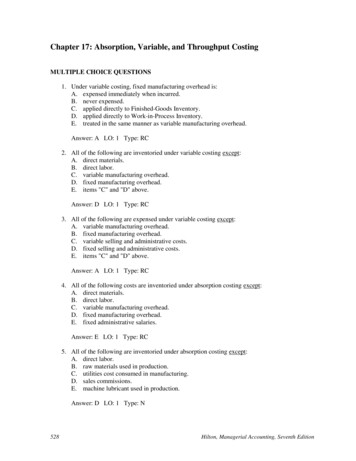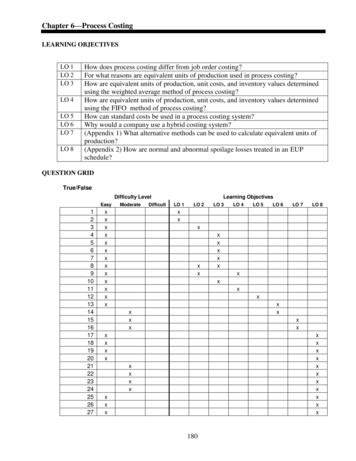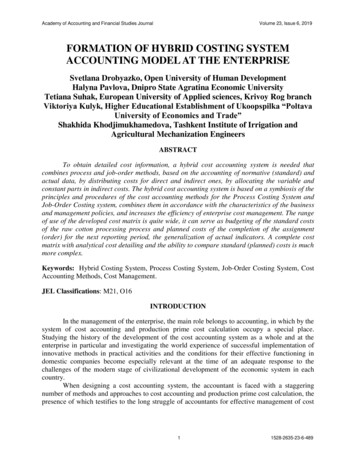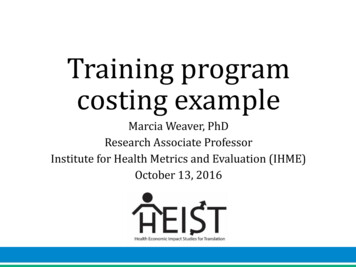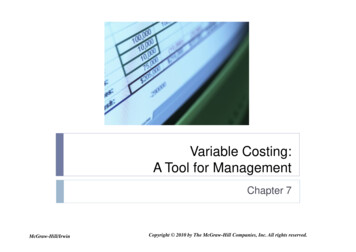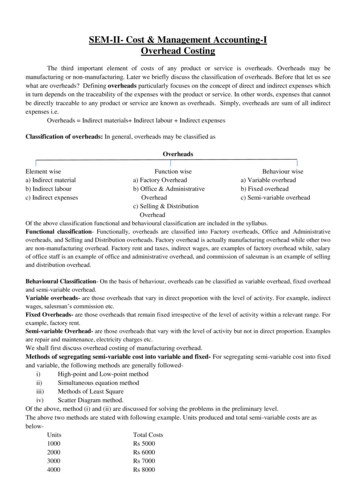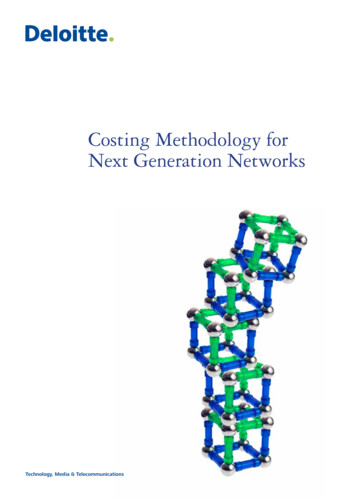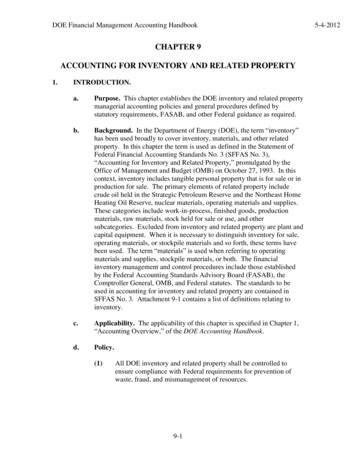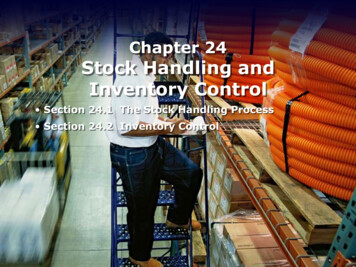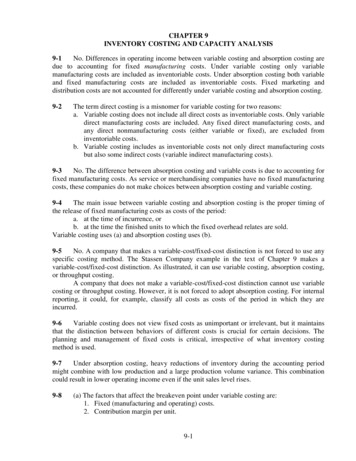
Transcription
CHAPTER 9INVENTORY COSTING AND CAPACITY ANALYSIS9-1No. Differences in operating income between variable costing and absorption costing aredue to accounting for fixed manufacturing costs. Under variable costing only variablemanufacturing costs are included as inventoriable costs. Under absorption costing both variableand fixed manufacturing costs are included as inventoriable costs. Fixed marketing anddistribution costs are not accounted for differently under variable costing and absorption costing.9-2The term direct costing is a misnomer for variable costing for two reasons:a. Variable costing does not include all direct costs as inventoriable costs. Only variabledirect manufacturing costs are included. Any fixed direct manufacturing costs, andany direct nonmanufacturing costs (either variable or fixed), are excluded frominventoriable costs.b. Variable costing includes as inventoriable costs not only direct manufacturing costsbut also some indirect costs (variable indirect manufacturing costs).9-3No. The difference between absorption costing and variable costs is due to accounting forfixed manufacturing costs. As service or merchandising companies have no fixed manufacturingcosts, these companies do not make choices between absorption costing and variable costing.9-4The main issue between variable costing and absorption costing is the proper timing ofthe release of fixed manufacturing costs as costs of the period:a. at the time of incurrence, orb. at the time the finished units to which the fixed overhead relates are sold.Variable costing uses (a) and absorption costing uses (b).9-5No. A company that makes a variable-cost/fixed-cost distinction is not forced to use anyspecific costing method. The Stassen Company example in the text of Chapter 9 makes avariable-cost/fixed-cost distinction. As illustrated, it can use variable costing, absorption costing,or throughput costing.A company that does not make a variable-cost/fixed-cost distinction cannot use variablecosting or throughput costing. However, it is not forced to adopt absorption costing. For internalreporting, it could, for example, classify all costs as costs of the period in which they areincurred.9-6Variable costing does not view fixed costs as unimportant or irrelevant, but it maintainsthat the distinction between behaviors of different costs is crucial for certain decisions. Theplanning and management of fixed costs is critical, irrespective of what inventory costingmethod is used.9-7Under absorption costing, heavy reductions of inventory during the accounting periodmight combine with low production and a large production volume variance. This combinationcould result in lower operating income even if the unit sales level rises.9-8(a) The factors that affect the breakeven point under variable costing are:1. Fixed (manufacturing and operating) costs.2. Contribution margin per unit.9-1
(b) The factors that affect the breakeven point under absorption costing are:1. Fixed (manufacturing and operating) costs.2. Contribution margin per unit.3. Production level in units in excess of breakeven sales in units.4. Denominator level chosen to set the fixed manufacturing cost rate.9-9Examples of dysfunctional decisions managers may make to increase reported operatingincome are:a. Plant managers may switch production to those orders that absorb the highest amountof fixed manufacturing overhead, irrespective of the demand by customers.b. Plant managers may accept a particular order to increase production even thoughanother plant in the same company is better suited to handle that order.c. Plant managers may defer maintenance beyond the current period to free up moretime for production.9-10 Approaches used to reduce the negative aspects associated with using absorption costinginclude:a. Change the accounting system: Adopt either variable or throughput costing, both of which reduce the incentivesof managers to produce for inventory. Adopt an inventory holding charge for managers who tie up funds in inventory.b. Extend the time period used to evaluate performance. By evaluating performanceover a longer time period (say, 3 to 5 years), the incentive to take short-run actionsthat reduce long-term income is lessened.c. Include nonfinancial as well as financial variables in the measures used to evaluateperformance.9-11 The theoretical capacity and practical capacity denominator-level concepts emphasizewhat a plant can supply. The normal capacity utilization and master-budget capacity utilizationconcepts emphasize what customers demand for products produced by a plant.9-12 The downward demand spiral is the continuing reduction in demand for a company‘sproduct that occurs when the prices of competitors‘ products are not met and (as demand dropsfurther), higher and higher unit costs result in more and more reluctance to meet competitors‘prices. Pricing decisions need to consider competitors and customers as well as costs.9-13 No. It depends on how a company handles the production-volume variance in the end-ofperiod financial statements. For example, if the adjusted allocation-rate approach is used, eachdenominator-level capacity concept will give the same financial statement numbers at year-end.9-14 For tax reporting in the U.S., the IRS requires only that indirect production costs are―fairly‖ apportioned among all items produced. Overhead rates based on normal or masterbudget capacity utilization, as well as the practical capacity concept are permitted. At year-end,proration of any variances between inventories and cost of goods sold is required (unless thevariance is immaterial in amount).9-15 No. The costs of having too much capacity/too little capacity involve revenueopportunities potentially forgone as well as costs of money tied up in plant assets.9-2
9-16 (30 min.) Variable and absorption costing, explaining operating-income differences.1.Key inputs for income statement computations areApril0500500350150Beginning inventoryProductionGoods available for saleUnits soldEnding inventoryMay15040055052030The budgeted fixed cost per unit and budgeted total manufacturing cost per unit under absorptioncosting are(a)(b)(c) (a) (b)(d)(e) (c) (d)(a)Budgeted fixed manufacturing costsBudgeted productionBudgeted fixed manufacturing cost per unitBudgeted variable manufacturing cost per unitBudgeted total manufacturing cost per unitApril 2,000,000500 4,000 10,000 14,000May 2,000,000500 4,000 10,000 14,000Variable costingApril 2011 8,400,000aRevenuesVariable costsBeginning inventoryVariable manufacturing costsbCost of goods available for saleDeduct ending inventorycVariable cost of goods solddVariable operating costsTotal variable costsContribution marginFixed costsFixed manufacturing costsFixed operating costsTotal fixed costsOperating incomea 24,000 350; 24,000 520b 10,000 500; 10,000 400 y 2011 12,480,000 ,0002,600,000 1,250,000c 10,000 150; 10,000 30d 3,000 350; 3,000 5209-36,760,0005,720,0002,600,000 3,120,000
(b)Absorption costingRevenuesaCost of goods soldBeginning inventoryVariable manufacturing costsbAllocated fixed manufacturing costscCost of goods available for saleDeduct ending inventorydAdjustment for prod.-vol. varianceeCost of goods soldGross marginOperating costsVariable operating costsfFixed operating costsTotal operating costsOperating incomeadbe 24,000 350; 24,000 520 10,000 500; 10,000 400c 4,000 500; 4,000 4002.April 2011 8,400,000 05,000,0002,000,0007,000,000(2,100,000)0May 2011 12,480,000 00 0001,560,000600,0001,650,000 1,850,0002,160,000 2,640,000 14,000 150; 14,000 30 2,000,000 – 2,000,000; 2,000,000 – 1,600,000f 3,000 350; 3,000 520Absorption-costing Variable-costingFixed manufacturing costs Fixed manufacturing costs– –operating incomeoperating incomein ending inventoryin beginning inventoryApril: 1,850,000 – 1,250,000 600,000 ( 4,000 150) – ( 0) 600,000May: 2,640,000 – 3,120,000 ( 4,000 30) – ( 4,000 150)– 480,000 120,000 – 600,000– 480,000 – 480,000The difference between absorption and variable costing is due solely to moving fixedmanufacturing costs into inventories as inventories increase (as in April) and out of inventoriesas they decrease (as in May).9-4
9-17(20 min.) Throughput costing (continuation of Exercise 9-16).1.April 2011aRevenues 8,400,000Direct material cost of goods soldBeginning inventoryDirect materials in goods 0bmanufactured3,350,000Cost of goods available for sale3,350,000cDeduct ending inventory(1,005,000)Total direct material cost of goods sold2,345,000Throughput margin6,055,000Other costsManufacturing costs3,650,000dOther operating costs1,650,000fTotal other costs5,300,000Operating income 755,000aebf 24,000 350; 24,000 520 6,700 500; 6,700 400c 6,700 150; 6,700 30d( 3,300 500) 2,000,0002.May 2011 12,480,000 ,0003,320,000e2,160,000g5,480,000 3,516,000( 3,300 400) 2,000,000( 3,000 350) 600,000g( 3,000 520) 600,000Operating income under:April 1,250,0001,850,000755,000Variable costingAbsorption costingThroughput costingMay 3,120,0002,640,0003,516,000In April, throughput costing has the lowest operating income, whereas in May throughputcosting has the highest operating income. Throughput costing puts greater emphasis on sales asthe source of operating income than does either absorption or variable costing.3.Throughput costing puts a penalty on production without a corresponding sale in thesame period. Costs other than direct materials that are variable with respect to production areexpensed in the period of incurrence, whereas under variable costing they would be capitalized.As a result, throughput costing provides less incentive to produce for inventory than eithervariable costing or absorption costing.9-5
9-18(40 min.) Variable and absorption costing, explaining operating-income differences.1.Key inputs for income statement computations are:Beginning inventoryProductionGoods available for saleUnits soldEnding 00800300March3001,2501,5501,50050The budgeted fixed manufacturing cost per unit and budgeted total manufacturing costper unit under absorption costing are:(a)(b)(c) (a) (b)(d)(e) (c) (d)Budgeted fixed manufacturing costsBudgeted productionBudgeted fixed manufacturing cost per unitBudgeted variable manufacturing cost per unitBudgeted total manufacturing cost per unit9-6January 400,0001,000 400 900 1,300February 400,0001,000 400 900 1,300March 400,0001,000 400 900 1,300
(a)Variable CostingRevenuesaVariable costsBeginning inventorybVariable manufacturing costscCost of goods available for saleDeduct ending inventorydVariable cost of goods soldVariable operating costseTotal variable costsContribution marginFixed costsFixed manufacturing costsFixed operating costsTotal fixed costsOperating incomeJanuary 2012 1,750,000 0900,000900,000(270,000)630,000420,000February 2012 2,000,000 000700,000400,000140,000March 2012 3,750,000 ,200,000800,000400,000140,000540,000 160,000400,000140,000540,000 260,000a 2,500 700; 2,500 800; 2,500 1,500b ? 0; 900 300; 900 300c 900 1,000; 900 800; 900 1,250d 900 300; 900 300; 900 50e 600 700; 600 800; 600 1,5009-72,250,0001,500,000540,000 960,000
(b)Absorption CostingRevenuesaCost of goods soldBeginning inventorybVariable manufacturing costscAllocated fixed manufacturingcostsdCost of goods available for saleDeduct ending inventoryeAdjustment for prod. vol. var.fCost of goods soldGross marginOperating costsVariable operating costsgFixed operating costsTotal operating costsOperating incomeJanuary 2012 1,750,000 February 2012 2,000,000March 2012 3,750,0000900,000 390,000720,000 0,0002,015,000(390,000)0(390,000)80,000 U910,000840,000420,000140,000(65,000)(100,000) F1,120,000880,000480,000140,000560,000 280,000900,000140,000620,000 260,000a 2,500 700; 2,500 800; 2,500 1,500 ? 0; 1,300 300; 1,300 300c 900 1,000; 900 800; 900 1,250d 400 1,000; 400 800; 400 1,250e 1,300 300; 1,300 300; 1,300 50f 400,000 – 400,000; 400,000 – 320,000; 400,000 – 500,000g 600 700; 600 800; 600 1,500b9-81,850,0001,900,0001,040,000 860,000
Absorption-costing Variable costing Fixed manufacturing Fixed manufacturing operatingoperatingcosts incosts in2. ending inventory beginning inventory incomeincome January: 280,000 – 160,000 ( 400 300) – 0 120,000 120,000February: 260,000 – 260,000 ( 400 300) – ( 400 300) 0 0March: 860,000 – 960,000 ( 400 50) – ( 400 300)– 100,000 – 100,000The difference between absorption and variable costing is due solely to moving fixedmanufacturing costs into inventories as inventories increase (as in January) and out ofinventories as they decrease (as in March).9-9
9-19(20–30 min.) Throughput costing (continuation of Exercise 9-18).1.JanuaryRevenuesaDirect material cost ofgoods soldBeginning inventorybDirect materials in goodsmanufacturedcCost of goods availablefor saleDeduct ending inventorydTotal direct materialcost of goods soldThroughput marginOther costsManufacturingeOperatingfTotal other costsOperating incomeFebruary 1,750,000 March 2,000,000 3,750,0000 150,000 0,000400,0001,600,000720,000620,0001,360,000 40,000750,0003,000,000900,0001,040,0001,340,000 260,0001,940,000 1,060,000a 2,500 700; 2,500 800;
Under absorption costing both variable and fixed manufacturing costs are included as inventoriable costs. Fixed marketing and distribution costs are not accounted for differently under variable costing and absorption costing. 9-2 The term direct costing is a misnomer for variable costing for two reasons: a. Variable costing does not include all .
